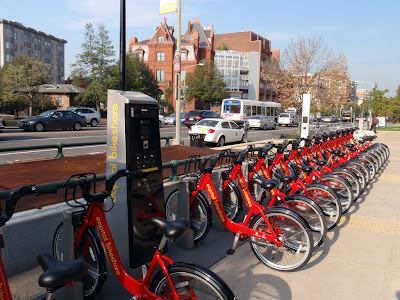Update: Survey results are available from here (26 April 2012).
I was sent an email about the survey (open until 5 PM on April 13th, info) a few days ago, so I figured this Herald article was coming. The news here is that the city (through Greenway Specialist Kim Greendahl) is entertaining the possibility of setting up either a staffed bicycle rental program (what I usually think of when I hear “bike rental”) or starting a bikeshare program (where riders could swipe a card at a kiosk, unlock a bicycle, ride it across town, and then deposit their bicycle in another kiosk).
I’ve only used one other bikeshare program, in Minneapolis last October, and I loved it because it let me get around as a visitor without needing to drive. Does anyone else have experiences to share with this sort of system in other cities?
The specific target for any sort of bicycle-providing system seems to be visitors/tourists to Grand Forks. I think this is exactly who would use a bicycle rental stand located on the Greenway: people from out of town who are looking for something to do. A bikeshare system could mean a little more for residents because it would allow people to mix their transportation options: ride a bicycle across town in the morning when it’s sunny, ride the bus home if it starts to rain later. Multiple kiosks mean multiple route possibilities and encourages people to ride.
What either of these systems does not do is get people to ride whose sole reason for not riding is lack of a bicycle. If you look around, cheap bikes are easy to get, so easy that the racks outside the UND dorms are chock full and that the Mission always seems to be surrounded by riders. It’s my hypothesis that supplying people with bicycles will not make them ride, and this is supported by ridership surveys for bikeshare systems such as the one in Washington, D.C.,* Minneapolis, MN, which is frequented predominantly by riders who already own another bike. What a bikeshare system does is allow people the flexibility to choose the best form of transportation for their immediate needs: car, bicycle, bus, foot, etc., without needing to head back and reclaim a bicycle they may have left locked up somewhere.
Given the choice, I’m in favor of a bikeshare system because it has the potential to serve all residents, however I imagine that a “trial” bike rental stand on the Greenway would be a good way to measure tourist use. Maybe a local business could step up to run such a thing, which brings me to my next question: how easy is it to rent a bicycle in Grand Forks, and where do you head for that?
*Originally I was remembering a post on Streetsblog about Washington, D.C. bikeshare, but that post was about comparing injury rates between bikeshare users and personal-bicycle users.



